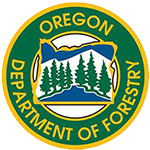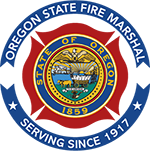Over the last decade, fire seasons have become longer and more challenging. At the same time, Oregon’s population continues to grow and increasing numbers of people are living in housing that is in or near forests, rangelands and other vegetation, called the Wildland-Urban Interface (WUI).
In response to these factors as well as the devastating 2020 Labor Day fires, the Oregon legislature passed a series of bipartisan bills in 2021 and 2023 to help people living in Oregon improve their wildfire preparedness.
As a result, wildfire scientists at Oregon State University (OSU) developed a map that characterizes wildfire hazard for each property across the state. The wildfire hazard map uses the best available science and data and incorporates the expertise of more than 50 fire and fuels professionals from around the state.
The ultimate goal of the map is to help people across Oregon better prepare for future wildfires.
How will the map be used?
The map WILL be used to:
- Improve the safety and well-being of communities across Oregon.
- Help Oregonians understand the wildfire hazard in their community.
- Help public agencies objectively prioritize wildfire hazard reduction efforts.
- Implement a statewide strategy to improve wildfire resilience.
- Inform where statewide defensible space codes may apply in high-hazard areas in the WUI.
The map will NOT be used to:
- Adjust insurance rates (by insurers).
- Make landowners modify the components of the building they live or work in unless significant updates are planned for structures within high hazard areas in the WUI.
The statewide wildfire hazard map will allow individuals, state agencies, Tribes, and organizations to make informed choices and improve efforts to mitigate future damage to Oregon communities.
Curious about the science behind the map or have more questions? See the FAQ and Understand the Map pages for more details.
Final wildfire hazard maps available
Updated and tentatively final maps of wildfire hazard and the wildland-urban interface are now available on the Oregon Explorer website. The designations for properties have been updated after review of public comments and input from county planners were received during the comment period in July and August of 2024. Updates were posted to the Oregon Explorer website on Jan. 7. The designations are final, unless there is a successful appeal of a property's designation.
Appealing designation of hazard zone or wildland-urban interface
Property owners with tax lots designated as both high wildfire hazard and within the wildland-urban interface were sent a packet of information by certified mail on Jan. 7. This packet included an appeal form and information about their rights under the contested case hearing process.
The deadline to file an appeal was March 10, 2025. Governor Kotek has requested that all appeal submissions be held, and not referred to the Office of Administrative Hearings, until after the legislative session concludes at the end of June. This will allow time for the Oregon Legislature to consider laws regarding the wildfire hazard map and associated provisions. If you’ve submitted an appeal for your property, the department will notify you on the next steps regarding your appeal request after the Legislative Session ends.
If you have questions about the appeals process, contact hazardmap@odf.oregon.gov.
Wildfire hazard map support call center
Call Center operations have now closed with the end of the appeal period. You may still email questions to hazardmap@odf.oregon.gov.
The development and implementation of Oregon’s statewide wildfire hazard map is a collaborative multi-agency effort. Learn more about each agency’s role in map development or use, and how they will use it in the future below:

Oregon State University
Oregon State University (OSU) is responsible specifically for technical development of the map, utilizing multiple data sets based on the best available wildfire science. OSU will distribute the final map via the online tool Oregon Explorer, and will update the map every five years or as future policy requires.

Oregon Department of Forestry
Oregon Department of Forestry (ODF) is responsible for policy development, interagency collaboration and the public engagement process regarding the map, including the homeowner notifications and appeals process.

Oregon State Fire Marshal
The Oregon State Fire Marshal (OSFM) is responsible for developing a defensible space code applied to properties in the high hazard class within the wildland-urban interface (WUI) across the state. Only buildings located inside the WUI and on a high hazard property will potentially be subject to the defensible space codes. Defensible space helps protect lives, reduces risk to structures in the event of a wildfire, and creates more resilient homes, people, and communities.

Department of Consumer and Business Services
Within the Department of Consumer and Business Services (DCBS), two divisions are doing work related to statewide wildfire risk: the Building Codes Division (BCD) and the Division of Financial Regulation (DFR). BCD is responsible for adopting fire hardening building code standards for new development and significant home updates in high wildfire hazard areas in the wildland-urban interface (WUI). DFR is the state insurance regulator and offers assistance to consumers regarding wildfire coverage by insurance policies.
How Can You Get Involved?
Landowners and communities across Oregon play an important role in wildfire preparedness, and many have already taken active steps to help create fire-adapted communities. Visit Wildfire Resources to learn more.
